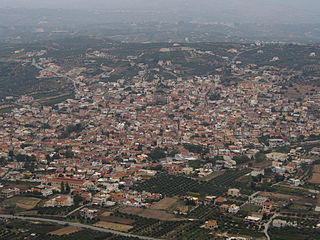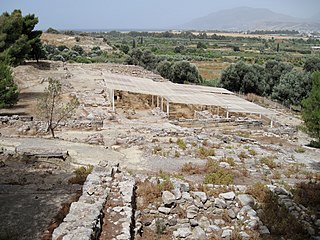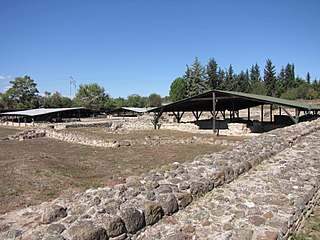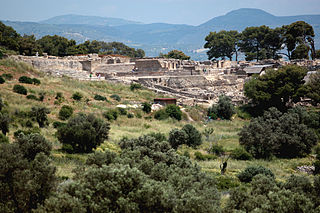 W
WActium or Aktion was a town on a promontory in ancient Acarnania at the entrance of the Ambraciot Gulf off which Octavian gained his celebrated victory, the Battle of Actium, over Antony and Cleopatra, on September 2, 31 BCE.
 W
WArchanes is a former municipality in the Heraklion regional unit, Crete, Greece. Since the 2011 local government reform it is part of the municipality Archanes-Asterousia, of which it is a municipal unit. The municipal unit has an area of 31.516 km2 (12.168 sq mi). Population 5,042 (2011). It is also the archaeological site of an ancient Minoan settlement in central Crete. The discovery of ancient roads leading from Archanes to Juktas, Anemospilia, Xeri Kara and Vathypetro indicate that Archanes was an important hub in the region during Minoan times. Archaeological evidence indicates that ancient Archanes spread out over the same area as the modern town of Archanes.
 W
WAthens is the capital and largest city of Greece. Athens dominates the Attica region and is one of the world's oldest cities, with its recorded history spanning over 3,400 years and its earliest human presence started somewhere between the 11th and 7th millennium BC.
 W
WBassae is an archaeological site in Oichalia, a municipality in the northeastern part of Messenia, Greece. In classical antiquity, it was part of Arcadia. Bassae lies near the village of Skliros, northeast of Figaleia, south of Andritsaina and west of Megalopolis. It is famous for the well-preserved mid- to late-5th century BC Temple of Apollo Epicurius.
 W
WChamaizi is an ancient archaeological site in eastern Crete with a Middle Minoan IA oval-shaped building. Below this building is evidence of Early Minoan building foundations.
 W
WDispilio is an archaeological site containing remains of a Neolithic lakeshore settlement that occupied an artificial island near the modern village of Dispilio on Lake Orestiada in Kastoria municipality, Western Macedonia, Greece.
 W
WEuonymeia, also known by its medieval name Trachones, and by its modern colloquial Ano Kalamaki, is a historic settlement in Athens and currently a residential neighborhood within the municipality of Alimos on the southern suburbs of Athens, Greece. The area is an inland part of the south Athenian plain, situated between the foothills of Mount Hymettus and the southern coastal zone of Athens on the Saronic Gulf. The land is characterized by limestone hills and streams running from Hymettus toward the coast. Situated 7 kilometres (4.3 mi) south of the center of Athens, Euonymeia has been developed and incorporated into the urban sprawl of the Greek capital.
 W
WFournou Korifi is the archaeological site of a Minoan settlement on southern Crete.
 W
WFranchthi Cave or Frankhthi Cave is an archaeological site overlooking Kiladha Bay, in the Argolic Gulf, opposite the village of Kiladha in southeastern Argolis, Greece.
 W
WHagia Photia is an archaeological site of a fortified ancient Minoan building on eastern Crete. Sitia lies five kilometers to the west.
 W
WHagia Triada is the archaeological site of an ancient Minoan settlement. Hagia Triada is situated on the western end of a prominent coastal ridge, with Phaistos at the eastern end and the Mesara Plain below.
 W
WIklaina is a historic village in the municipal unit of Pylos, Messenia, Greece. It is situated in low hills, approximately 10 km to the northeast of the town of Pylos. Important archaeological remains of the Late Bronze Age period have been brought to light through excavations and surface survey by the Athens Archaeological Society and the University of Missouri–St. Louis under the direction of Professor Michael Cosmopoulos. The finds include an early Mycenaean palace, giant terrace walls, murals, an advanced drainage system, and a clay tablet from between 1450 and 1350 B.C. featuring an early example of Linear B writing. Other periods represented are the Late Classical and the Byzantine.
 W
WKarfi is an archaeological site high up in the Dikti Mountains in eastern Crete, Greece. The ancient name of the site is unknown; "Karfi" is a local toponym for the prominent knob of limestone that marks the peak of the site, especially when viewed from the north. Located approximately 1100 meters above sea level, and overlooking the northern entrance to the Lasithi Plateau, the dramatic situation of Karfi is somewhat akin to that of the famous Inca site of Machu Picchu in Peru. While there is some evidence that the site was used during the Middle Minoan period as a peak sanctuary, Karfi is best known as a large and extensively excavated town of the Late Minoan IIIC period at the beginning of the Greek "Dark Ages."
 W
WKavousi Kastro is an archaeological site in eastern Crete, Greece, about 1.4 km southeast of the modern village of Kavousi, a historic village in the municipality of Ierapetra in the prefecture of Lasithi.
 W
WKavousi Vronda is an archaeological site in eastern Crete, Greece, located about 1.25 km south of the modern village of Kavousi, a historic village in the municipality of Ierapetra in the prefecture of Lasithi.
 W
WIn classical Greece, Lerna was a region of springs and a former lake near the east coast of the Peloponnesus, south of Argos. Even though much of the area is marshy, Lerna is located on a geographically narrow point between mountains and the sea, along an ancient route from the Argolid to the southern Peloponnese; this location could have potentially resulted in the importance of the settlement.
 W
WIn the construction of the railway line between Athens and Thessaloniki, a fortified bishop's seat from the Byzantine era was discovered in Louloudies.
 W
WPyrgos is an archaeological site of the Minoan civilization near Myrtos in the municipality of Ierapetra on the south coast of Crete. Pyrgos provides evidence of settlements along the southern Ierapetra Isthmus. This site has had a long history due to its valuable location and geography. It is located close to the Myrtos valley and has a harbor with a nearby mountain range providing its protection. The settlement includes a courtyard, many rooms, a country house and a tomb.
 W
WNichoria is a site in Messenia, on a ridgetop near modern Rizomylos, at the northwestern corner of the Messenian Gulf. From the Middle to Late Bronze Age it cultivated olive and terebinth for export. During the Helladic period it was part of the Mycenaean civilisation.
 W
WPhaistos, also transliterated as Phaestos, Festos and Latin Phaestus, is a Bronze Age archaeological site at modern Faistos, a municipality in south central Crete. Ancient Phaistos was located about 5.6 km (3.5 mi) east of the Mediterranean Sea and 62 km (39 mi) south of Heraklio, the second largest city of Minoan Crete. The name Phaistos survives from ancient Greek references to a city in Crete of that name at or near the current ruins.
 W
WPhilippi was a major Greek city northwest of the nearby island, Thasos. Its original name was Crenides after its establishment by Thasian colonists in 360/359 BC. The city was renamed by Philip II of Macedon in 356 BC and abandoned in the 14th century after the Ottoman conquest. The present municipality, Filippoi, is located near the ruins of the ancient city and is part of the region of East Macedonia and Thrace in Kavala, Greece. It was classified as a UNESCO World Heritage Site in 2016.
 W
WPriniatikos Pyrgos is an archaeological site near Istron River, in the eastern Cretan regional unit of Lasithi, (Greece). The nearest big town is Agios Nikolaos, Crete. The site is on a coastal promontory. It appears to have been first settled in the Final Neolithic, circa 3000 BC. Nearby, there's a small resort town of Kalo Chorio, Lasithi. It is not to be confused with Myrtos Pyrgos on the south coast.
 W
WPseira is an islet in the Gulf of Mirabello in northeastern Crete with the archaeological remains of Minoan and Mycenean civilisation.
 W
WRoussolakkos is the site of an important Minoan city, located near Palekastro, Crete. It is the only Minoan city to have survived intact. Its harbor, outlying settlements, sanctuaries, and quarries are preserved under sediments accumulating over more than 2,000 years. It was here, the ancient authors tell us, that Diktaian Zeus was born and where this young god founded his holy city. A temple to Zeus was built at the nearby Elaea promontory. It was also here that Jason and the Argonauts confronted Talos, the man of bronze, a generation before the Trojan War.
 W
WSklavokampos is the archaeological site of an ancient Minoan settlement in Crete, used during the Late Minoan period.
 W
WStylos is an archaeological site of an ancient Minoan settlement and cemetery near the modern village of Stylos on the Greek island of Crete. Stylos means "column" in Greek. Stylos is near the important archaeological site of Aptera in Chania regional unit. The site was first excavated by N. Platon and C. Davaras. A potter's kiln, a building with four rooms and a Late Minoan tholos tomb have been excavated.
 W
WTylisos is a town and a former municipality in the Heraklion regional unit, Crete, Greece. Since the 2011 local government reform it is part of the municipality Malevizi, of which it is a municipal unit. The municipal unit has an area of 131.064 km2 (50.604 sq mi). Population 2,867 in 2011. It is an ancient Minoan peak sanctuary and town. The Municipality of Tylisos was created in 1999 and includes 11 villages. The economy is based on agriculture, mainly grape cultivation and olive cultivation. At the same time stock farming of sheep, goats and chickens and beehive farms are abundant.
 W
WVathypetro is an archaeological site, four kilometres south of the town of Archanes on Crete (Greece). It contains some of the oldest wine presses in the world. Excavations began in 1949 by the Greek archaeologist Spyridon Marinatos. The estate contains a manor house or villa which had a prominent role in the rural region around Archanes. The complex consists of several buildings, courtyards and workshop spaces. Next to the individual houses is the Minoan wine press, a plant for the production of olive, a Minoan kiln and ceramics, and the remains of an ancient pottery workshop.